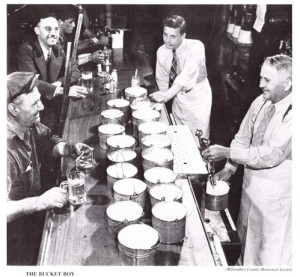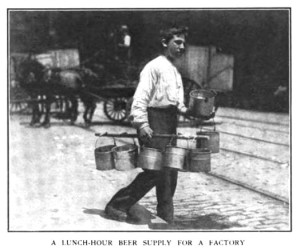If you’re a micro-brew lover, chances are you own not one but several growlers, perhaps one from each of your favorite beer brands. Bringing that shiny jug into a brewery and getting it filled up with the sweet, sweet nectar of amber alcohol goodness is one of life’s greatest beer gifts! And although it seems as if growlers have only been around since the modern renaissance of craft beer this past decade, they’ve actually been around for centuries. How the name “growler” came into American vernacular is debatable, but the history of the growler is both interesting and not without controversy.
 Back in the 1800s, before pasteurization and bottled beer, fresh beer was carried in 2 quart galvanized or enameled pails or buckets, and sometimes jugs, called “growlers,” maybe because bartenders wouldn’t fill the pails completely up and made the customer growl. Maybe when the beer sloshed around the pail, it created a “growling” sound as the CO2 escaped the lid. Of course, this was back in the days when “bucket boys” would “Rush the Growler” and deliver the pails of beer to workers during their lunch hour or after work, as workers would head home.
Back in the 1800s, before pasteurization and bottled beer, fresh beer was carried in 2 quart galvanized or enameled pails or buckets, and sometimes jugs, called “growlers,” maybe because bartenders wouldn’t fill the pails completely up and made the customer growl. Maybe when the beer sloshed around the pail, it created a “growling” sound as the CO2 escaped the lid. Of course, this was back in the days when “bucket boys” would “Rush the Growler” and deliver the pails of beer to workers during their lunch hour or after work, as workers would head home.
Back then, beer was sold as pints, but most bartenders by tradition filled the growlers with nearly a quart of beer. A standard fill would cost a whopping 5 – 15 cents a pop.
 The “Bucket Trade” was frequently attacked during the decades leading up to Prohibition in 1920 by the same anti-alcohol “temperance” forces that would result in the 18th Amendment. Laws were passed in many communities to outlaw the growler entirely, often with the support of saloon owners and brewers. Twenty cities prohibited the growler trade and 24 other cities reported some restrictions on it. Several restrictions were in the form of prohibition to sell in this way to women and to minors. Wilmington, DE required an extra license of $25 from dealers who supplied the growler trade. Four cities withheld the growler privilege from saloons, permitting it only in the case of dealers other than those selling by the drink. Eight cities limited the quantity which might be sold in a growler. One pint at a time was the limit set in states from New Jersey to California, and pressure was put on local law officials to enforce laws concerning minors buying beer and sensational articles regarding bucket boys and girls were a feature of many newspapers of the era.
The “Bucket Trade” was frequently attacked during the decades leading up to Prohibition in 1920 by the same anti-alcohol “temperance” forces that would result in the 18th Amendment. Laws were passed in many communities to outlaw the growler entirely, often with the support of saloon owners and brewers. Twenty cities prohibited the growler trade and 24 other cities reported some restrictions on it. Several restrictions were in the form of prohibition to sell in this way to women and to minors. Wilmington, DE required an extra license of $25 from dealers who supplied the growler trade. Four cities withheld the growler privilege from saloons, permitting it only in the case of dealers other than those selling by the drink. Eight cities limited the quantity which might be sold in a growler. One pint at a time was the limit set in states from New Jersey to California, and pressure was put on local law officials to enforce laws concerning minors buying beer and sensational articles regarding bucket boys and girls were a feature of many newspapers of the era.
Sunday closings laws were often ignored since Sunday was often the only non-work day at the time, and thus a popular day for growler sales. This led to the invention of a concealable growler – a lidded, metal curved, flask-like container that came complete with a hook to allow the owner to secure it to the inside underarm of his coat, to hide the beer from public view and the police while “rushing the growler”. They eventually came to be known as “ducks” – a term that predated the unit and in some regions, had long been a synonym for a growler/pail/bucket/can of beer. The “duck” term would even survive Prohibition and be used for glass “mason jar” half gallon jugs used in Baltimore, complete with breweries’ logos.

Post-prohibition, around 1935, brewers began selling their beer in “silver growlers,” or cans. Take out beer in the 50s consisted of filling waxed cardboard containers with lids, similar to Chinese food containers, and by the 60s, packaged beer was available for sale after hours, so the use of the growler somewhat died out. However, in 1989, when Charlie Otto and his father wanted to offer beer to their customers at the Grand Teton Brewing Company but did not have the facilities to bottle their beer, they started offering ½ gallon glass growlers with their logo silkscreened on the side. Thus began the rebirth of the modern-day growler.
Nowadays, choices for growlers are endless. Growlers have become so ubiquitous that tap rooms or “Growleries” are popping up all over the place, and they can hook you up with just about any kind of growler you can imagine, from insulated stainless steel “Hydro Flasks” to mini-kegs and tempered glass jugs with ornate pewter handles. Most common glass growlers cost anywhere from $4-$10 at a local taproom or brewery. Nicer insulated stainless steel growlers can go for $50, and fancier ceramic jugs can run upwards of a whopping $130.